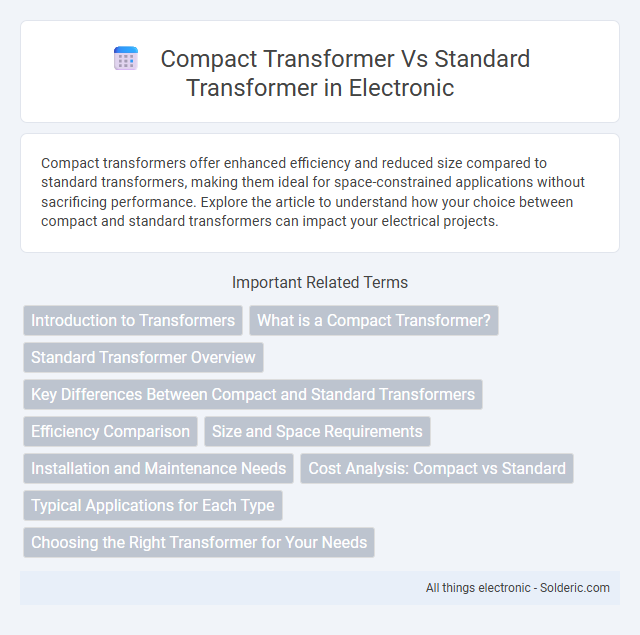Compact transformers offer enhanced efficiency and reduced size compared to standard transformers, making them ideal for space-constrained applications without sacrificing performance. Explore the article to understand how your choice between compact and standard transformers can impact your electrical projects.
Comparison Table
| Feature | Compact Transformer | Standard Transformer |
|---|---|---|
| Model Size | Smaller, optimized for efficiency | Larger, full-scale architecture |
| Parameters | Fewer parameters, reduced complexity | High parameter count, more complex |
| Computation | Lower computational cost | High computational demand |
| Memory Usage | Lightweight, less memory | Heavy memory requirement |
| Latency | Faster inference speed | Slower due to complexity |
| Use Cases | Edge devices, real-time applications | Large-scale NLP, research |
| Performance | Competitive on specific tasks | State-of-the-art across tasks |
Introduction to Transformers
Transformers are deep learning models designed for processing sequential data through self-attention mechanisms, enabling efficient handling of long-range dependencies. Compact Transformers optimize this architecture by reducing the number of parameters and computational complexity while maintaining performance, typically through techniques like parameter sharing and sparse attention. Standard Transformers, originally introduced in the "Attention Is All You Need" paper, rely on fully connected self-attention layers that demand significant memory and computation, especially in large-scale applications.
What is a Compact Transformer?
A Compact Transformer is a streamlined variant of the standard transformer model designed to reduce computational complexity and memory usage while maintaining performance. It achieves efficiency through techniques such as parameter sharing, reduced layer count, and optimized attention mechanisms. This architecture is ideal for deployment in resource-constrained environments like mobile devices and edge computing.
Standard Transformer Overview
The Standard Transformer architecture, introduced by Vaswani et al. in 2017, is based on self-attention mechanisms facilitating parallel processing and long-range dependency capture in sequences. It consists of stacked encoder and decoder layers with multi-head attention, positional encoding, and feed-forward neural networks, enabling effective translation and language modeling tasks. Despite its high accuracy, the standard transformer demands significant computational resources and memory, limiting its deployment in resource-constrained environments.
Key Differences Between Compact and Standard Transformers
Compact transformers offer a smaller footprint and enhanced energy efficiency compared to standard transformers, making them ideal for space-constrained applications. Standard transformers typically provide higher power ratings and greater insulation levels, suitable for large-scale industrial and utility use. The compact design often utilizes advanced materials and cooling techniques, resulting in reduced weight and improved thermal management relative to standard models.
Efficiency Comparison
Compact transformers exhibit significantly higher efficiency compared to standard transformers due to reduced core losses and optimized winding designs. Their smaller size and lower weight contribute to decreased copper and core material usage, leading to improved energy performance and cost savings. In applications requiring frequent load cycling, compact transformers maintain better voltage regulation and thermal management, further enhancing operational efficiency.
Size and Space Requirements
Compact transformers significantly reduce size and space requirements compared to standard transformers by utilizing advanced winding techniques and high-efficiency magnetic materials. Their design allows for installation in confined areas without compromising electrical performance, making them ideal for applications with limited space. Your choice of a compact transformer optimizes equipment layout and conserves valuable real estate in industrial or commercial settings.
Installation and Maintenance Needs
Compact transformers require less space and simpler installation processes compared to standard transformers, making them ideal for environments with limited room or quick deployment needs. Their reduced size and fewer components lead to lower maintenance demands and easier access for routine checks or repairs. Standard transformers often involve more complex installation procedures and higher maintenance costs due to their larger size and increased number of parts.
Cost Analysis: Compact vs Standard
Compact transformers offer significant cost savings compared to standard transformers, primarily due to reduced material usage and smaller physical size, which lowers manufacturing and transportation expenses. Your overall installation and maintenance costs are also minimized with compact transformers because of their easier handling and lower energy losses. Standard transformers, while often more robust for high-capacity applications, generally incur higher upfront and operational costs due to larger cores and greater insulation requirements.
Typical Applications for Each Type
Compact transformers are predominantly used in residential lighting, low-power electronics, and signal processing where space-saving and efficiency are critical. Standard transformers find applications in industrial power distribution, large-scale electrical substations, and heavy machinery requiring high voltage regulation and robust performance. Choosing between the two depends on factors like power capacity, physical size constraints, and the operational environment.
Choosing the Right Transformer for Your Needs
Compact transformers offer a smaller footprint and reduced weight, making them ideal for applications with space constraints and portable devices. Standard transformers provide higher power capacity and greater efficiency, suitable for industrial and heavy-duty electrical systems. Selecting the right transformer depends on balancing power requirements, size limitations, and efficiency demands specific to the intended use case.
compact transformer vs standard transformer Infographic

 solderic.com
solderic.com